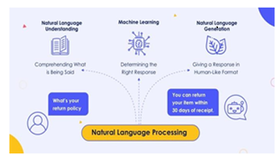Semantic Search Using Natural Language Processing
Tagged: Computer Science
Introduction
Natural Language Processing (NLP) is a method of analysing texts using computers. The study of how a person understands and uses language is a component of NLP. This is for the creation of tools and techniques that allow computer systems to interpret and modify natural languages in order to accomplish a variety of useful activities. NLP researchers are presently working on well-developed NLP systems that take into account the general text as well as a significant percentage of a language's unpredictability and ambiguity. Speech recognition, word separation, and other issues in computational linguistics are all frequent. Developing statistical techniques to it has been common practise in NLP 1 .
Introduction
Natural Language Processing (NLP) is a method of analysing texts using computers. The study of how a person understands and uses language is a component of NLP. This is for the creation of tools and techniques that allow computer systems to interpret and modify natural languages in order to accomplish a variety of useful activities. NLP researchers are presently working on well-developed NLP systems that take into account the general text as well as a significant percentage of a language's unpredictability and ambiguity. Speech recognition, word separation, and other issues in computational linguistics are all frequent. Developing statistical techniques to it has been common practise in NLP 1 .

Fig1. Natural Language Processing (NLP)2
Less Searching & More Finding with Semantic Search
Since its inception in the early 1990s, the basic search engine has come a long way. However, with the help of artificial intelligence (AI) technologies such as machine learning (ML) and natural language processing, it has just lately made significant progress toward providing much more nuanced and relevant responses. Semantic search is created by incorporating AI capabilities into search engines. Searches are no longer limited to terms and their dictionary definitions: According to Towards Data Science, semantic search entails deciphering the query's intent and describing the "information in a fashion suitable for meaningful retrieval.3"
Semantic Search makes use of machine learning to improve accuracy and relevance by learning from previous query results. NLP is used to allow the searcher to frame their questions as if they were chatting to a human. This allows them to devote less effort to brainstorming the ideal keywords for a given search. Semantic search can process data from a variety of sources, including email, social media, documents, PDFs, photos, video, and audio, unlike its keyword-based predecessor. This greatly widens the searcher's options by allowing them to use all of the resources available to them to locate what they're searching for4.
For Organizations, Semantic Search is Worthwhile Investment
There hasn't been a single company that wouldn't profit from getting faster, more accurate, and higher-quality outcomes. Semantic search allows less searching and more discovery by removing irrelevant material and presenting just the most accurate replies.
Consider an underwater welder looking for tools to finish a project on a 1,500-foot-deep oil rig in the Gulf of Mexico. The multidimensional character of this work would be missed by a keyword search, which would only return entries connected to welding. A semantic search would recognise the context of such a project and recognise that the searcher is first and foremost a diver, and then a welder5 . It would provide relevant results, such as a hyperbaric chamber, and consider elements such as working conditions and water currents.
By integrating NLP with a user-friendly interface, semantic search may give additional business benefits, making it simple for anybody to interact with and locate the results they seek. In firms of all sizes, having quick access to reliable results aids decision-making and boosts productivity. Semantic search may also help businesses grow and thrive by bringing together unstructured data from many sources6 .
Where Have We Seen Semantic Research?
Google, unsurprisingly, has been using semantic search to improve its user experience since the Hummingbird update in 2013. This upgrade added “conversational search” to its capabilities, which means that the context of the entire query is considered instead of individual words.
Zappos, an online store, recently added semantic search to their website to help visitors find exactly what they're looking for fast and simply. The system, according to the company's chief data scientist, not only understands the context of the search word, but also tailors the result to each customer's previous search data7 . As a result, Zappos is able to provide each of their consumers with the results that are most relevant to them on an individual basis.
As the benefits of semantic search becomes more apparent, companies around the world will increasingly turn to platforms like Microsoft Azure and AWS Comprehend, which allow them to use the technology without having to build it themselves.
Conclusion
Using semantic search effectively also entails breaking down any data silos that may exist inside a company to ensure that no critical information is overlooked8 . Organizations may train their semantic search engine to deliver the most informed and accurate results by ensuring that employees are open with the essential data and that sufficient technical preparation is in place.
While it may appear that semantic search is a mature technology, there is still a long way to go. That isn't to say we shouldn't start taking advantage of its many advantages now, rather than waiting until its full powers are realised: Businesses of all sizes may utilise semantic search to make faster, more informed decisions, improve user experience, and ultimately grow their bottom line9 .
Reference
- https://sci-hub.se/10.1561/1500000032
- https://bluewhaleapps.com/blog/improve-your-apps-with-natural-language-processing
- https://sci-hub.se/10.1148/rg.307105083
- https://sci-hub.se/10.1109/icsc.2009.51
- https://sci-hub.se/10.2200/s00741ed1v01y201611wbe015
- https://sci-hub.se/10.1109/CBI49978.2020.10065
- http://www.bargiela.com/papers/a35.pdf
- https://www.conferenceie.ase.ro/wp-content/uploads/2019/06/ProceedingsIE2019/semantic_search_in_social_media_analysis.pdf
- https://sci-hub.se/10.1016/j.eswa.2013.02.011

